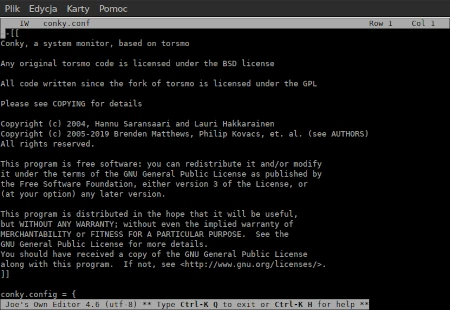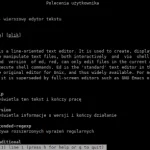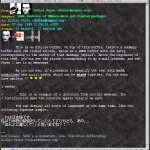Last Updated on: 11th December 2023, 02:29 pm
Web site: joe-editor.sourceforge.io
Category: Office
Subcategory: Text Editors
Platform: Linux, OS X, UNIX-like, Windows, DOS, BeOS
License: GNU GPL
Interface: CLI
Wikipedia: JOE’s Own Editor
First release: August 22, 1991
JOE – a full featured terminal-based screen editor which is distributed under the GNU General Public License (GPL). JOE has been around since 1988 and comes standard with many Linux distributions.
JOE is being maintained by its original author Joseph Allen, plus all of the people who send bug reports, feature suggestions and patches to the project web site.
JOE is written in C and its only dependency is libc. This makes JOE very easy to build (just “configure” and “make install”), making it feasible to include on small systems and recovery disks. The compiled binary is about 300K in x86. Note that JOE can use either the termcap or terminfo terminal capabilities databases (or a built-in termcap entry for ANSI terminals). The choice is controlled by a “configure” option. If terminfo is used, a library is required to access the database (on some systems this library is ncurses, but JOE does not use curses to control the terminal- it has its own code for this).
Features:
– Multi-file search and replace- file list is either given on command line or by a UNIX command (grep/find) run from within JOE.
– Mouse support, including wheel (works best when using xterm). The mouse can resize windows, scroll windows, select and paste text, and select menu entries.
– Context display on status line: allows you to see name of function cursor is in.
– UTF-8 support, optional auto-detect of UTF-8 files.
– Syntax highlighting for more than 40 languages.
– Hexadecimal edit mode. Use JOE as a disk editor: joe -overwrite -hex /dev/hda1,0,512 (edit first sector of /dev/hda1).
– Non-destructive editing of binary files even when handling MS-DOS or UNIX line endings.
– Swap file allows editing files larger than memory.
– Context sensitive on-line help.
– Bash-like TAB completion and history for all prompts, or jump into the completion menu and use it to traverse the file system.
– Complete word in edit buffer by hitting ESC Enter (uses other words in buffer for dictionary).
– EMACS-compatible file locks and file modification checking.
– Shell windows.
– Multiple-windows onto same or different files.
– Compile and step through errors or Grep and step through finds.
– Goto matching character delimiter “() [] {} <>” which skips comments and quoted matter.
– Goto matching word delimiter, including XML tags and C preprocessor directives.
– Ctrl-arrow key block selection.
– Search and replace system, including regular expression and optional incremental search. Regular expression key for matching balanced C expressions.
– Tags file search (tab completion at tags search prompt uses tags file as database).
– Spell check commands which invoke aspell or ispell. Language for aspell can be passed through editor.
– Paragraph format which preserves news/mail quoting indentation characters.
– Unlimited Undo and Redo.
– Yank buffer allows stepping through and insertion of previously deleted text.
– State file restores history buffers, yank buffer and last file cursor positions.
– Cursor position history allows you to step through previously visited areas of a file.
– Multiple interactive keyboard macros. Macros can be assigned to key sequences in joerc file.
– Block move/copy/delete/filter.
– Rectangle (columnar) block mode- search and replace can be narrowed to the rectangular block. Rectangular blocks can be filtered through UNIX commands.
– Overtype/Insert modes.
– Indent/Unindent (shift block left or right).
– Auto-indent mode.
– Picture mode for ASCII graphics.
– Line number mode displays line number of each line.
– Powerful scientific calculator with block statistics functions (sum/standard-deviation/count highlighted block of numbers).
– Termcap/Terminfo support allows JOE to use any terminal or terminal emulator.
– Can accept data from a pipe.





